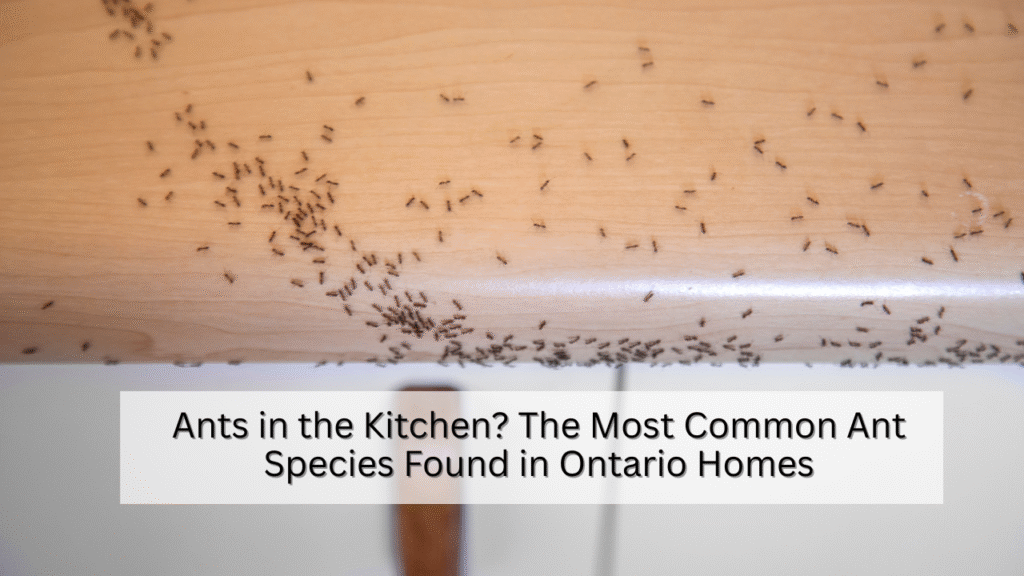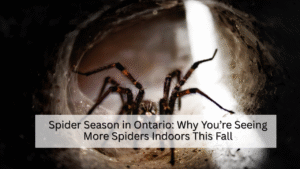You wake up, walk into the kitchen, and see a trail of tiny ants marching across the counter. You wipe them up and by afternoon, they’re back. Sound familiar?
Ants are one of the most common pests in Ontario homes. They don’t bite (most of the time), but they invade in numbers that make you wonder where they’re coming from and why they’re so hard to get rid of.
Here’s the thing: not all ants are the same. Some just want crumbs. Others chew through wood or electrical wiring. To really fix the problem, you have to know which type of ant you’re dealing with and what they’re after.
Why Ants Love Your Kitchen
Ants don’t show up randomly. They’re there for food, water, or warmth, usually all three.
Your kitchen, bathroom, or basement is perfect because it provides steady moisture, crumbs, and hiding spots.
Even a few drops of juice or a bread crumb under the toaster is enough to bring in a scout ant. Once it finds food, it leaves a scent trail for others to follow. Within hours, that one ant becomes a colony-sized parade.
If you keep cleaning and they keep coming back, there’s likely a nest hidden nearby, inside a wall, under the floor, or even behind appliances.
The 5 Most Common Ants in Ontario Homes
Ontario has dozens of ant species, but five cause most of the trouble indoors.
Here’s how to spot them and what makes each one unique.
1. Carpenter Ants – The Wood Destroyers
If you’re seeing large black ants, usually between 6 and 12 mm long, they’re likely carpenter ants.
These ants don’t eat wood, they tunnel through it to build nests. That means they can damage window frames, decks, and even structural beams.
Signs to watch for:
- Sawdust-like shavings near baseboards or windowsills
- Rustling noises inside walls at night
- Ants appearing after rain or in springtime
Why they’re dangerous:
Carpenter ants weaken wooden structures from the inside. They’re one of the few household ants that can cause real property damage.
How to control them:
Find and remove the main nest, often in damp wood near leaks or insulation. Using sprays only kills the visible ants, not the colony. Professionals use dust or bait treatments that reach deep into the tunnels.
2. Pavement Ants – The Driveway Wanderers
Small, brownish-black ants (about 3 mm long) often found near driveways, patios, or sidewalks are pavement ants.
They nest under concrete slabs and sometimes move indoors during hot or wet weather.
Signs to watch for:
- Dirt mounds near cracks in pavement
- Lines of ants along baseboards or kitchen tiles
Why they’re a nuisance:
They contaminate food and can spread bacteria from garbage areas to your kitchen. While they don’t bite, they multiply fast and can form multiple colonies around your home.
How to control them:
Seal gaps in concrete, caulk door frames, and vacuum up visible ants. Baits are effective because these ants share food with their colony.
3. Pharaoh Ants – The Tiny Trouble-Makers
These ants are tiny, barely 2 mm long and yellowish or reddish in color. Don’t let their size fool you. They’re one of the hardest ants to eliminate because they have multiple queens and nest inside walls, floors, and appliances.
Signs to watch for:
- Very small ants appearing near sinks or food areas
- Multiple trails in kitchens or bathrooms
Why they’re difficult:
When disturbed, pharaoh ants split their colony into smaller nests, a behavior called “budding.” So if you spray them, you can end up with five colonies instead of one.
How to control them:
Avoid sprays. Use slow-acting bait that workers carry back to all the queens. Professional-grade baits are the only reliable fix.
4. Odorous House Ants – The Smelly Ones
These ants are medium-sized (3–4 mm), brown or black, and live up to their name.
When crushed, they release a rotten coconut smell, a dead giveaway that you’re dealing with odorous house ants.
Signs to watch for:
- Ants following trails along baseboards or windowsills
- Clusters near sugary foods, pet bowls, or sticky residues
Why they’re annoying:
They move their nests frequently, especially when disturbed or during rain. That’s why DIY efforts often fail, they just relocate.
How to control them:
Clean surfaces with vinegar to remove scent trails, store sweets in sealed containers, and use targeted bait stations. If the infestation keeps returning, there’s likely a hidden nest under the floor or behind walls.
5. Field Ants – The Yard Builders
You’ll see these ants mostly outdoors, but they can wander indoors in summer.
They’re larger than pavement ants and build visible mounds in lawns, gardens, and around foundations.
Signs to watch for:
- Dirt piles near trees or patios
- Occasional ants entering through basement windows or cracks
Why they matter:
Field ants don’t usually nest indoors, but their outdoor colonies can grow huge and disrupt lawns. They also bite when disturbed, not venomous, but painful.
How to control them:
Destroy mounds by drenching them with insecticidal soap or bait granules. For recurring colonies, professional treatment around the perimeter helps prevent re-entry.
Why DIY Ant Killers Rarely Work
You can find dozens of “ant killer” sprays at the store, but most only target the ants you see. The real problem is the colony, which can be hiding several meters away.
Killing visible ants just makes the colony send more workers. If you use strong repellent sprays, it may cause the colony to scatter and form new nests, especially with species like pharaoh or odorous ants.
That’s why professionals use bait systems, they’re slow-acting and designed to be shared. Workers bring the bait back to the nest, and over time, it wipes out the entire colony, including the queens.
How to Prevent Ants from Coming Back
The best way to control ants is to make your home less attractive in the first place.
Here’s how:
- Seal Entry Points
Use caulk around doors, windows, and pipes. Even tiny cracks are enough for ants to sneak through. - Fix Moisture Problems
Ants love damp wood and leaks. Repair dripping faucets and check under sinks. - Clean Regularly
Wipe spills right away and vacuum crumbs daily in kitchens and dining areas. - Store Food Properly
Keep pantry items in airtight containers. Don’t leave pet food out overnight. - Trim Plants Near the House
Ants use branches and vines as bridges to reach your walls. - Schedule Routine Pest Inspections
One visit a year can catch small infestations before they grow.
These small habits keep your kitchen ant-free year-round.
When to Call a Professional
If you’ve been battling ants for weeks and they keep reappearing, it’s time to get expert help.
Professional technicians can identify the exact species, locate the nest, and use safe, targeted treatments that work long-term.
At BugManagers, our team handles ant control across Ontario including carpenter, pharaoh, and pavement ants. We don’t just kill the visible ones. We trace them to their source, treat the nest, and seal entry points so they don’t return.
We use pet-safe, eco-friendly solutions designed for Canadian homes and weather conditions. No harsh chemical smells. No wasted effort.
A Quick Word About Carpenter Ant Damage
If you’re hearing rustling sounds in the walls or finding piles of sawdust near windowsills, don’t wait.
Carpenter ants can slowly hollow out wood, much like termites. The sooner you act, the less you’ll spend on repairs.
Our technicians can inspect your home, find the moisture source, and repair minor wood damage before it spreads. It’s always cheaper to handle it early.
Final Thoughts
Ants might be small, but they’re persistent. Once they find food and shelter, they’ll return again and again unless you eliminate the source.
The key is to identify the species, clean thoroughly, and remove what’s attracting them. And if that doesn’t do it, professional help is just a call away.
At BugManagers, we specialize in smart, safe, and effective ant control for homes and businesses across Ontario.
Whether it’s carpenter ants in the attic or sugar ants in your kitchen, we’ll help you take back your space, quickly and permanently.
Because your home should feel clean, comfortable, and yours again, not theirs.







